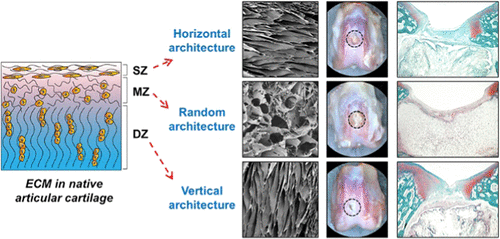当前位置:
X-MOL 学术
›
ACS Biomater. Sci. Eng.
›
论文详情
Our official English website, www.x-mol.net, welcomes your feedback! (Note: you will need to create a separate account there.)
Cell-Free Biomimetic Scaffold with Cartilage Extracellular Matrix-Like Architectures for In Situ Inductive Regeneration of Osteochondral Defects
ACS Biomaterials Science & Engineering ( IF 5.8 ) Pub Date : 2020-12-02 , DOI: 10.1021/acsbiomaterials.0c01276 Wei Zhang 1, 2, 3 , Chen Ling 4 , Xiaolong Li 1 , Renwang Sheng 1 , Haoyang Liu 1 , Aini Zhang 1 , Yujie Jiang 1 , Jialin Chen 1, 2, 3 , Qingqiang Yao 3, 4
ACS Biomaterials Science & Engineering ( IF 5.8 ) Pub Date : 2020-12-02 , DOI: 10.1021/acsbiomaterials.0c01276 Wei Zhang 1, 2, 3 , Chen Ling 4 , Xiaolong Li 1 , Renwang Sheng 1 , Haoyang Liu 1 , Aini Zhang 1 , Yujie Jiang 1 , Jialin Chen 1, 2, 3 , Qingqiang Yao 3, 4
Affiliation

|
The development of a biomimetic scaffold designed to provide a native extracellular matrix (ECM)-like microenvironment is a potential strategy for cartilage repair. The ECM in native articular cartilage is structurally composed of three different architectural zones, i.e., horizontally aligned, randomly arranged, and vertically aligned collagen fibers. However, the effects of scaffolds with these three different ECM-like architectures on in vivo cartilage regeneration are not clear. In this study, we aim to systematically investigate and compare their in situ inductive regenerative efficacy on cartilage defects. ECM-mimetic silk fibroin scaffolds with horizontally aligned, vertically aligned, and random pore architectures are fabricated using the controlled directional freezing technique. All of these scaffolds exhibit similar pore area, swelling ratio, and in vitro degradation behavior. Nevertheless, the aligned scaffolds have a higher pore aspect ratio and hydrophilicity, and increase the proliferation of bone marrow-derived mesenchymal stem cells (BMSCs) in vitro. When implanted into rabbit osteochondral defects, the scaffold with vertically aligned pore architectures provides a more cell-favorable microenvironment conducive to endogenous BMSCs than other scaffolds and supports the simultaneous regeneration of cartilage and subchondral bone. These findings indicate that scaffolds with vertically aligned ECM-like architectures serve as an effective cell-free and growth factor-free scaffold for enhanced endogenous osteochondral regeneration.
中文翻译:

无软骨的仿生支架,具有软骨细胞外基质样结构,用于软骨软骨缺损的原位诱导再生。
仿生支架的开发旨在提供天然的细胞外基质(ECM)样微环境是软骨修复的潜在策略。天然关节软骨中的ECM在结构上由三个不同的建筑区域组成,即水平排列,随机排列和垂直排列的胶原纤维。但是,尚不清楚具有这三种不同的类ECM架构的支架对体内软骨再生的影响。在这项研究中,我们旨在系统地调查和比较它们的原位对软骨缺损的诱导再生功效。使用可控定向冷冻技术制造具有水平排列,垂直排列和随机孔结构的ECM模拟丝素蛋白支架。所有这些支架都表现出相似的孔面积,溶胀率和体外降解行为。然而,对齐的支架具有更高的孔长宽比和亲水性,并增加了骨髓间充质干细胞(BMSCs)的体外增殖。当植入到兔骨软骨缺损中时,具有垂直排列的孔结构的支架比其他支架提供了更有利于细胞内源性BMSC的微环境,并支持软骨和软骨下骨的同时再生。这些发现表明,具有垂直排列的ECM样结构的支架可作为有效的无细胞和无生长因子的支架,用于增强内源性骨软骨再生。
更新日期:2020-12-14
中文翻译:

无软骨的仿生支架,具有软骨细胞外基质样结构,用于软骨软骨缺损的原位诱导再生。
仿生支架的开发旨在提供天然的细胞外基质(ECM)样微环境是软骨修复的潜在策略。天然关节软骨中的ECM在结构上由三个不同的建筑区域组成,即水平排列,随机排列和垂直排列的胶原纤维。但是,尚不清楚具有这三种不同的类ECM架构的支架对体内软骨再生的影响。在这项研究中,我们旨在系统地调查和比较它们的原位对软骨缺损的诱导再生功效。使用可控定向冷冻技术制造具有水平排列,垂直排列和随机孔结构的ECM模拟丝素蛋白支架。所有这些支架都表现出相似的孔面积,溶胀率和体外降解行为。然而,对齐的支架具有更高的孔长宽比和亲水性,并增加了骨髓间充质干细胞(BMSCs)的体外增殖。当植入到兔骨软骨缺损中时,具有垂直排列的孔结构的支架比其他支架提供了更有利于细胞内源性BMSC的微环境,并支持软骨和软骨下骨的同时再生。这些发现表明,具有垂直排列的ECM样结构的支架可作为有效的无细胞和无生长因子的支架,用于增强内源性骨软骨再生。



























 京公网安备 11010802027423号
京公网安备 11010802027423号